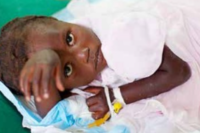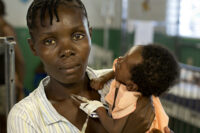Jean-Watson Fils began 2010 as a talented teacher, an eager accounting student and a devoted family member. The earthquake drastically altered his course. Like too many others in Port au Prince, Watson found himself amidst the street rubble. His brother was dead and Watson barely clung to life. Exposed tendons and muscles popped from his left arm and a huge piece of skin sliced open his forehead. Severe infection began building and dehydration and blood loss drained off what little energy and life force he had left. Even so, Watson managed to keep his tenuous hold on life for five days before help arrived.
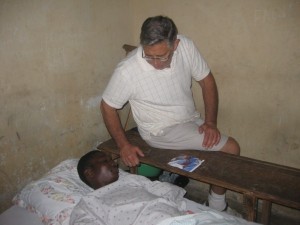 During the chaos of massive casualties that followed the earthquake, two corpsmen from the Coast Guard Cutter MOHAWK had the difficult task of triaging the injured. Initially, they decided not to work on Watson because he was so badly injured they did not think he would survive and others needed their assistance. But that night, neither corpsman could sleep thinking about him. Independently, they decided Watson would be the first person they would work on the next day, if he was still alive. Come daybreak, Watson was still alive. The corpsmen stabilized him and loaded him on a USCGC TAHOMA helicopter bound for Hôpital Sacré Coeur, where Watson became HSC’s first earthquake patient.
During the chaos of massive casualties that followed the earthquake, two corpsmen from the Coast Guard Cutter MOHAWK had the difficult task of triaging the injured. Initially, they decided not to work on Watson because he was so badly injured they did not think he would survive and others needed their assistance. But that night, neither corpsman could sleep thinking about him. Independently, they decided Watson would be the first person they would work on the next day, if he was still alive. Come daybreak, Watson was still alive. The corpsmen stabilized him and loaded him on a USCGC TAHOMA helicopter bound for Hôpital Sacré Coeur, where Watson became HSC’s first earthquake patient.
General surgeon, Dr. Stephen Fletcher, and anesthesiologist, Dr. Rick Pitera, both from Holy Name Hospital in Livingston, New Jersey, had just arrived in Milot when the chopper landed. Fletcher and Pitera were immediately pressed into service, taking Watson into surgery— the type of surgery rarely performed during peace time. Dr. Fletcher removed Watson’s entire arm including most of his shoulder in order to save his life. Pitera used his expertise to keep Watson’s battered body functioning during the extremely difficult surgery. Fletcher was sewing up Watson’s facial lacerations when Dr. Daniel Burzon, another surgeon from New Jersey, entered the patient waiting area outside the Operating Room.
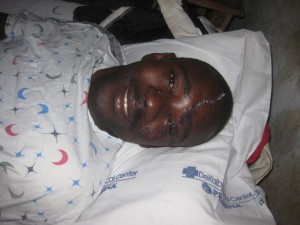 “I asked why ALL the staff, even in the waiting room, were wearing face masks when I smelled the smell that explained it: decayed flesh from the patient which we were told had a tourniquet up for 5 days cutting off all blood supply to the limb but essentially saving his life, “ recalls Burzon. “There was a plastic bag on him to keep the infection and smell in. Clearly this man would not be alive had it not been for the corpsmen who brought him up to Milot and Dr. Fletcher and his team.”
“I asked why ALL the staff, even in the waiting room, were wearing face masks when I smelled the smell that explained it: decayed flesh from the patient which we were told had a tourniquet up for 5 days cutting off all blood supply to the limb but essentially saving his life, “ recalls Burzon. “There was a plastic bag on him to keep the infection and smell in. Clearly this man would not be alive had it not been for the corpsmen who brought him up to Milot and Dr. Fletcher and his team.”
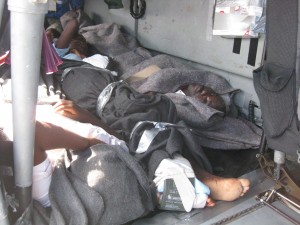 Six months and several surgeries later, Watson was ready to return to Port au Prince for a time before coming back to Milot to be fitted for his “new arm” from the Prosthetics Workshop. Not only had he made remarkable progress in healing physically, Watson was well on his way to conquering two additional challenges: his fear of being underneath a “concrete ceiling” and his fear of not being able to work again. As the hospital staff noted, Watson was so grateful for the gift of life given to him by God, he was able to use this fear to motivate himself to become a leader. He was a positive influence with many of the other patients. While recovering, he requested that he be “put to work” by teaching basic math and Creole to patients in the pediatric tent as well as those in tent city. As Watson says, he feels like a “stronger man” because he can “do anything.”
Six months and several surgeries later, Watson was ready to return to Port au Prince for a time before coming back to Milot to be fitted for his “new arm” from the Prosthetics Workshop. Not only had he made remarkable progress in healing physically, Watson was well on his way to conquering two additional challenges: his fear of being underneath a “concrete ceiling” and his fear of not being able to work again. As the hospital staff noted, Watson was so grateful for the gift of life given to him by God, he was able to use this fear to motivate himself to become a leader. He was a positive influence with many of the other patients. While recovering, he requested that he be “put to work” by teaching basic math and Creole to patients in the pediatric tent as well as those in tent city. As Watson says, he feels like a “stronger man” because he can “do anything.”
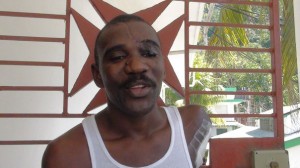 While meeting with CRUDEM Executive Director, Denise Kelly, in mid-June, Watson expressed his sincere gratitude for the tremendous efforts involved earthquake relief. “He asked me to thank the pilots again for their crucial role in saving his life, “said Kelly. “ He said that he knew he was in a very bad way and that it looked as though January 16th would be his last day alive but he did not lose hope. And now here he is!”
While meeting with CRUDEM Executive Director, Denise Kelly, in mid-June, Watson expressed his sincere gratitude for the tremendous efforts involved earthquake relief. “He asked me to thank the pilots again for their crucial role in saving his life, “said Kelly. “ He said that he knew he was in a very bad way and that it looked as though January 16th would be his last day alive but he did not lose hope. And now here he is!”
As USCGC TAHOMA Executive Officer LCDR Michael P. Fisher wrote CRUDEM, “With estimates of hundreds of thousands killed, what we were able to do seemed so small. This [the story of Jean-Watson Fils] is a reminder that for every individual helped, it wasn’t a “small thing” for them.”





